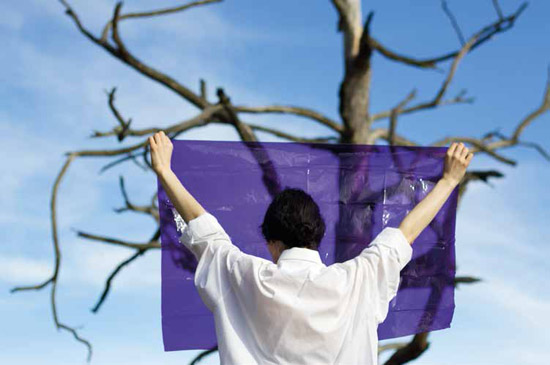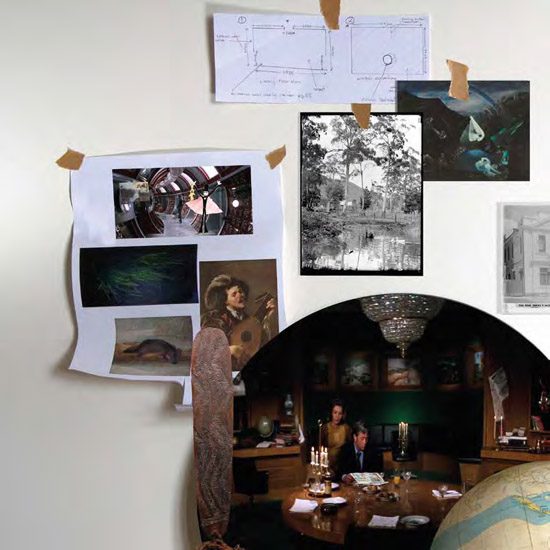Andrew Frost visits the TarraWarra Biennial 2014…
Some exhibitions have a sense of completeness. You walk through a show, taking in the individual works. If you’re there on your own time, which is to say you’re there to look at art for pleasure, the logic of an exhibition will assemble itself in your mind simply from the experience of looking. If you’re there in a professional capacity – which is to say you’re there to review or write about it – the curatorial idea is much more present in your thinking: on the one hand there are the art works and on the other there’s the exhibition’s rationale. Is it working? Why is that piece here and not some other? How is this relevant to the overall narrative? Can you just put all this aside and let the experience wash over you? The answer is never cut and dried. [Let’s just think about that while I jot down some notes in the Moleskine]. Curatorial themes, concepts and rationales are tricky things, especially when they’re overdetermined try-hard ideas that seem forced or silly and can kill the whole enterprise. Other exhibitions somehow just work – and it’s like magic – the premise is strong enough to hold the thing together but still loose enough for the mind to fly off to other ideas, possibilities and associations.
Whisper in My Mask: TarraWarra Biennial 2014 – the fifth iteration of the TarraWarra museum’s flagship event this time around curated by Natalie King and Djon Mundine – is the sort of show that just makes sense. It takes its inspiration in part from the lyrics to Art Groupie, a 1981 song by Grace Jones [Love me in a picture/Kiss me in a cast/Touch me in a sculpture/Whisper in my mask] but that is just a starting point. Masks and masking can be taken literally and a number of works either depict masks, are actual masks or mask objects from view. Other works are more tangential, the concept or the construction a kind of obfuscation. At a time when the mask has such cultural relevancy, and has somehow become a point of contention among the politically naive, WIMM arrives at an almost perfect moment for an exhibition that encompasses a wide range of work by a racially diverse group of artists. If contemporary art has a claim to meaningful social critique, albeit a critique driven by aesthetic considerations, then this is the exactly kind of coincidence of curatorial idea and real world politics that the 2014 Biennale of Sydney should have been.
Soren Dahlgaard‘s Dough Portraits [2014] are large-scale photographs of people with a giant wad of dough on their heads completely obscuring individual identities beyond clothing choices – Hawaiian shirts, windbreakers, brocade shirts – and skin colour. The scale of the works overcomes the inherent absurdity of the images casting them from the ridiculous into the realm of the foreboding. This effect seemed even more pronounced with Dahlgaard’s work hanging in the same room as a long line of Tony Garifalakis‘s blacked-out Bloodline [2014] images: head and shoulders portraits of royalty complete with crowns and jewels, their identities blasted away by a blob of black paint, some with eyes and lips still eerily showing. Both Dahlgaard and Garifalakis’s work switched back and forth between the literal and the metaphorical being simultaneously a masking and unmasking of identity and power. The effectiveness of the curatorial idea of putting these works in close proximity – along with Garifalakis’s The Hills Have Eyes [2012] a camouflage fabric with eyes peeking out from the pattern – was enhanced by the Elizabeth Pedler‘s Smokescreen [2013-14] set up in a room right next door. Pedler’s work requires the viewer to first don a protective face mask, then enter a room willed with tiny, white polystyrene balls and three strong fans. It’s like walking into a toxic snow storm – fun at first but then something you want to get out of. Was the colour of the plastic symbolic perhaps? It wasn’t certain but those damned balls are still falling out of my clothes and bag a week later.
The overtly political aspect of masks and masking were in contrast to masks in more specific cultural contexts. The Boat-People group’s Muffled [2010] was and remains a pointed political statement on nationalism. The group’s members stood on the Opera House steps in Sydney and in Federation Square in Melbourne, their identities obscured by Australian flags. It was a concise message that transmitted its idea without need of interpretation. Karla Dickens‘s You Winsome You Lose Some [2013], images of people sporting metal head gear and masks offered a kind of mid-point in the idea of the mask itself – faces were again obscured but not entirely. In the images documenting various people wearing the masks it was possible to get a sense of who they were, yet they could presumably see out unhindered. As a metaphor for the cultural biases it was an elegant and thought provoking action.
The idea of obscuring or erasing was disturbingly evident in Romaine Morton‘s video Ragtag [2010]. A fountain statue that stands near the tourist centre at the Blue Mountains adjacent to the Three Sisters lookout purports to be a representation of an Aboriginal dreaming story and features three nude life size female figures. In reality it’s nothing of the sort, having sprung from the imagination of a non-Aboriginal artist. Morton’s video documents the dressing of the statues by the artist and her accomplices and their interactions with tourists and locals believing they were vandalising the work. While there was certainly humour in the piece, the video highlighted the unreal quality of the tourist experience and the cartoonish representation of racial identity in the sculpture that is a common feature of Australian ‘beauty spot’ destinations.
Where a number of works used masking and identity more deliberately, WIMM also included work of a far more metaphorical and tangential nature. Daniel Boyd‘s glue-on-linen images, accretions of white dots that conjure ghost images of men in tribal dress or portrait photographs, move between certainty and ambiguity. Gabriella and Sylvia Mangano’s Lux [2014] is a two-screen video projection that presents landscape images obscured by coloured gels and scrims. Although the work comes with a pretty standard video art work soundtrack the simplicity of the piece was its real success and is perhaps my favourite work of the artists to date. If only more video works had this beauty and brevity.
In TarraWarra’s long side hall a temporary office had been set up by The Telepathy Project’s Veronica Kent and Sean Peoples as an installation entitled Reading Solaris to The Great Moorool [2014]. In the room a desk and shelves were set up with books, documents and mirrors, somewhere a video was playing Andrei Tarkovsky’s Solaris [1972]. The installation was just part of a much bigger project that involved a series of lectures that tied the film and its sentient ocean to Indigenous stories of water spirits, as well as a night at the Healesville pub where people were invited to come and rub the edges of glasses. While I had remained completely unmoved and puzzled by the Telepathy Project’s work in Primavera 2014, there was enough intriguing associative content in the WIMM work to make me curious to see more.
Whisper in My Mask: TarraWarra Biennial 2014 runs until November 16.



